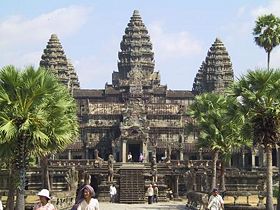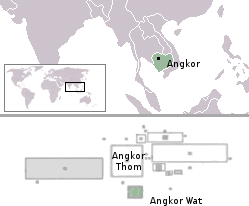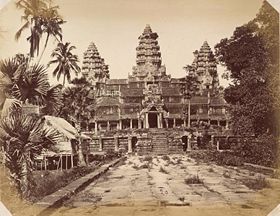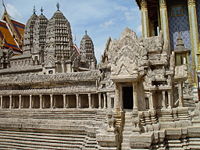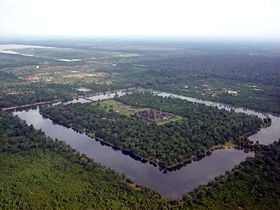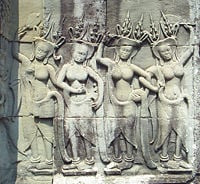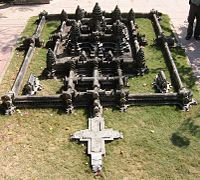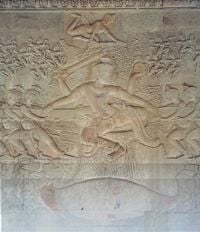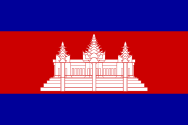Angkor Wat
Angkor Wat (meaning: "Capital Temple") is an ancient temple complex (originally Hindu but later becomming Buddhist) dating from the twelfth century C.E.. It is located at Angkor, Cambodia. The title "Angkor Wat" is the modern name of the temple; its original name is unknown.[1]
Built for king Suryavarman II in the early twelfth century as his state temple and capital city, Angkor Wat was the epitome of the high classical style of Khmer architecture. The temple was designed to represent Mount Meru, home of the gods in Hindu mythology. It combines two basic plans of Khmer temple architecture: the temple mountain and the later galleried temples. It is surrounded by a moat and an outer wall 3.6 km (2.2 miles) long with three rectangular galleries, each raised above the next. At the center of the temple stands a quincunx of towers. Unlike most Angkorian temples, Angkor Wat is oriented to the west; scholars are divided as to the significance of this. Originally constructed as a temple dedicated to the Hindu god Vishnu, it switched hands to Theravada Buddhism in the fourteenth or fifteenth century.
Angkor Wat has become a symbol of Cambodia, appearing on its national flag. It is the country's prime attraction for visitors. The site remains a significant Buddhist religious center in Cambodia today. The temple is admired for its extensive bas-reliefs and the numerous devatas adorning its walls, as well as for its grandeur and harmony of architecture.
History
The initial design and construction of the temple took place in the first half of the twelfth century, during the reign of Suryavarman II (ruled 1113 – c. 1150). Dedicated to Vishnu, it was built as the king's state temple and capital city. As neither the foundation stela nor any contemporary inscriptions referring to the temple have been found, its original name is unknown. It is located 5.5 km north of the modern town of Siem Reap, and a short distance south and slightly east of the previous capital, which was centered on the Baphuon temple. Work seems to have come to an end on the king's death, with some of the bas-reliefs unfinished.[2] In 1177 Angkor was sacked by the Chams, the traditional enemies of the Khmer. Thereafter the empire was restored by a new king, Jayavarman VII, who established a new capital and state temple (Angkor Thom and the Bayon respectively) which lie a few kilometers to the north. Angkor Wat is unusual among the Angkor temples because it was never completely abandoned. Its moat also provided some protection from encroachment by the jungle.[3]
In the fourteenth or fifteenth century the temple was converted to Theravada Buddhist use, which continues to the present day.
One of the first Western visitors to the temple was Antonio da Magdalena, a Portuguese monk who visited it in 1586 and said that the temple "is of such extraordinary construction that it is not possible to describe it with a pen, particularly since it is like no other building in the world. It has towers and decoration and all the refinements which the human genius can conceive of."[4] However, the temple was popularised in the West only in the mid-ninteenth century on the publication of Henri Mouhot's travel notes. The French explorer wrote of it:
One of these temples—a rival to that of Solomon, and erected by some ancient Michelangelo—might take an honourable place beside our most beautiful buildings. It is grander than anything left to us by Greece or Rome, and presents a sad contrast to the state of barbarism in which the nation is now plunged.[5]
Mouhot, like other early Western visitors, was unable to believe that the Khmers could have built the temple, and mistakenly dated it to around the same era as Rome.
In the twentieth century, Angkor Wat underwent considerable restoration work including the removal of accumulated earth and vegetation.[6] Work was interrupted by the civil war and Khmer Rouge control of the country during the 1970s and 1980s, but relatively little damage was done during this period other than the theft and destruction of mostly post-Angkorian statues.[7]
Architectural Style
Angkor Wat is the prime example of the classical style of Khmer architecture—the Angkor Wat style—to which it has given its name. By the twelfth century Khmer architects had become more skilled and confident than before in the use of sandstone (rather than brick or laterite) as their main building material. The Angkor Wat style was followed by that of the Bayon period, in which quality was often sacrificed to quantity.[8]
Angkor Wat has drawn praise above all for the harmony of its design. According to Maurice Glaize, a mid-twentieth-century conservator of Angkor, the temple "attains a classic perfection by the restrained monumentality of its finely balanced elements and the precise arrangement of its proportions. It is a work of power, unity and style." [9]
Architecturally, the elements characteristic of the style include: the ogival, redented towers shaped like lotus buds; half-galleries to broaden passageways; axial galleries connecting enclosures; and the cruciform terraces which appear along the main axis of the temple. Most of the visible areas are of sandstone blocks, while laterite was used for the outer wall and for hidden structural parts. The binding agent used to join the blocks is yet to be identified, although natural resins or slaked lime have been suggested.[10] Other elements of the design have been destroyed by looting and the passage of time, including gilded stucco on the towers, gilding on some figures on the bas-reliefs, and wooden ceiling panels and doors. [11] Typical decorative elements are devatas (or apsaras), bas-reliefs, and on pediments extensive garlands and narrative scenes. Statuary is conservative, being more static and less graceful than earlier work.[12]
The site
Angkor Wat temple is a representation of Mount Meru, the home of the gods in Hinduism: the central quincunx of towers symbolises the five peaks of the mountain, and the walls and moat the surrounding mountain ranges and ocean.[13] Access to the upper areas of the temple was progressively more exclusive, with the laity being admitted only to the lowest level.[14]
Unlike most Khmer temples, Angkor Wat is oriented to the west rather than the east. This has led many (including Glaize and George Coedès) to conclude that Suryavarman intended it to serve as his funerary temple. Further evidence for this view is provided by the bas-reliefs, which proceed in an anti-clockwise direction—prasavya in Hindu terminology—as this is the reverse of the normal order. Rituals take place in reverse order during Brahminic funeral services.[15] The archaeologist Charles Higham also describes a container which may have been a funerary jar which was recovered from the central tower.[16] Freeman and Jacques, however, note that several other temples of Angkor depart from the typical eastern orientation, and suggest that Angkor Wat's alignment was due to its dedication to Vishnu, who was associated with the west. [17]
A further interpretation of Angkor Wat has been proposed by Eleanor Mannikka. Drawing on the temple's alignment and dimensions, and on the content and arrangement of the bas-reliefs, she argues that these indicate a claimed new era of peace under king Suryavarman II: "as the measurements of solar and lunar time cycles were built into the sacred space of Angkor Wat, this divine mandate to rule was anchored to consecrated chambers and corridors meant to perpetuate the king's power and to honor and placate the deities manifest in the heavens above."[18] Mannikka's suggestions have been received with a mixture of interest and scepticism in academic circles.[19] She distances herself from the speculations of others, such as Graham Hancock, that Angkor Wat is part of a representation of the constellation Draco.[20]
Outer enclosure
The outer wall, 1025 by 802 meters and 4.5 meters high, is surrounded by a 30-meter apron of open ground and a moat 190 meters wide. Access to the temple is by an earth bank to the east and a sandstone causeway to the west; the latter, the main entrance, is a later addition, possibly replacing a wooden bridge.[21] There are gopuras at each of the cardinal points; the western is the largest and has three ruined towers. Glaize notes that this gopura both hides and echoes the form of the temple proper.[22] Under the southern tower is a statue of Vishnu, known as Ta Reach, which may originally have occupied the temple's central shrine.[23] Galleries run between the towers and as far as two further entrances on either side of the gopura often referred to as "elephant gates," as they are large enough to admit those animals. These galleries have square pillars on the outer (west) side and a closed wall on the inner (east) side. The ceiling between the pillars is decorated with lotus rosettes; the west face of the wall with dancing figures; and the east face of the wall with balustered windows, dancing male figures on prancing animals, and devatas, including (south of the entrance) the only one in the temple to be showing her teeth.
The outer wall encloses a space of 820,000 square meters (203 acres), which besides the temple proper was originally occupied by the city and, to the north of the temple, the royal palace. Like all secular buildings of Angkor, these were built of perishable materials rather than of stone, so nothing remains of them except the outlines of some of the streets.[24] Most of the area is now covered by forest. A 350 m causeway connects the western gopura to the temple proper, with naga balustrades and six sets of steps leading down to the city on either side. Each side also features a library with entrances at each cardinal point, in front of the third set of stairs from the entrance, and a pond between the library and the temple itself. The ponds are later additions to the design, as is the cruciform terrace guarded by lions connecting the causeway to the central structure.[25]
Central structure
The temple proper stands on a terrace raised above the level of the city. It consists essentially of three rectangular galleries rising to a central tower; with each level higher than the last. Mannikka interprets these galleries as being dedicated to the king, Brahma and the moon, and Vishnu, respectively.[26] Each gallery has a gopura at each of the cardinal points, and the two inner galleries each have towers at their corners, forming a quincunx with the central tower. Because of the temple's westward orientation, the features are all set back towards the east, leaving more space to be filled in each enclosure and gallery on the west side; for the same reason the west-facing steps are shallower than those on the other sides.
The outer gallery measures 187 by 215 meters, with pavilions rather than towers at the corners. The gallery is open to the outside of the temple, with columned half-galleries extending and buttressing the structure. The inner walls bear a series of bas-reliefs, depicting large-scale scenes mainly from the Ramayana and the Mahabharata. Higham has called these, "the greatest known linear arrangement of stone carving".[27] From the north-west corner anti-clockwise, the western gallery shows the Battle of Lanka (from the Ramayana, in which Rama defeats Ravana) and the Battle of Kurukshetra (from the Mahabharata, showing the mutual annihilation of the Kaurava and Pandava clans). On the southern gallery follow the only historical scene, a procession of Suryavarman II, then the 32 hells and 37 heavens of Hindu mythology. Glaize writes of;
those unfortunate souls who are to be thrown down to hell to suffer a refined cruelty which, at times, seems to be a little disproportionate to the severity of the crimes committed. So it is that people who have damaged others' property have their bones broken, that the glutton is cleaved in two, that rice thieves are afflicted with enormous bellies of hot iron, that those who picked the flowers in the garden of Shiva have their heads pierced with nails, and thieves are exposed to cold discomfort.[28]
On the eastern gallery is one of the most celebrated scenes, the Churning of the Sea of Milk, showing 92 asuras and 88 devas using the serpent Vasuki to churn the sea under Vishnu's direction (Mannikka counts only 91 asuras, and explains the asymmetrical numbers as representing the number of days from the winter solstice to the spring equinox, and from the equinox to the summer solstice).[29] It is followed by Vishnu defeating asuras (a 16th-century addition). The northern gallery shows Krishna's victory over Bana (where according to Glaize, "The workmanship is at its worst"[30]) and a battle between the Hindu gods and asuras. The north-west and south-west corner pavilions both feature much smaller-scale scenes, some unidentified but most from the Ramayana or the life of Krishna.
Connecting the outer gallery to the second enclosure on the west side is a cruciform cloister, known by the modern name of Preah Poan (the "Hall of a Thousand Buddhas"). Buddha images were left in the cloister by pilgrims over the centuries, although most have now been removed. This area has many inscriptions relating the good deeds of pilgrims, most written in Khmer but others in Burmese and Japanese. The four small courtyards marked out by the cloister may originally have been filled with water.[31] North and south of the cloister are libraries.
Beyond, the second and inner galleries are connected to each other and to two flanking libraries by another cruciform terrace, again a later addition. From the second level upwards, devatas abound on the walls. The second-level enclosure is 100 by 115 m, and may originally have been flooded to represent the ocean around Mount Meru.[32] Three sets of steps on each side lead up to the corner towers and gopuras of the inner gallery. The very steep stairways represent the difficulty of ascending to the kingdom of the gods.[33] This inner gallery, called the Bakan, is a 60 meter square with axial galleries connecting each gopura with the central shrine, and subsidiary shrines located below the corner towers. The roofings of the galleries are decorated with the motif of the body of a snake ending in the heads of lions or garudas. Carved lintels and pediments decorate the entrances to the galleries and to the shrines. The tower above the central shrine rises 43 m to a height of 65 m above the ground; unlike those of previous temple mountains, the central tower is raised above the surrounding four.[34] The shrine itself, originally occupied by a statue of Vishnu and open on each side, was walled in when the temple was converted to Theravada Buddhism, the new walls featuring standing Buddhas. In 1934 the conservator George Trouvé excavated the pit beneath the central shrine: filled with sand and water it had already been robbed of its treasure, but he did find a sacred foundation deposit of gold leaf two metres above ground level.[35]
Angkor Wat today
Since the 1990s Angkor Wat has seen a resumption of conservation efforts and a massive increase in tourism. The temple is part of a World Heritage Site, established in 1992, which has provided some funding and has encouraged the Cambodian government to protect the site.[36] The German Apsara Conservation Project (GACP) is working to protect the devatas and other bas-reliefs which decorate the temple from damage. The organization's survey found that around 20 percent of the devatas were in very poor condition, mainly because of natural erosion and deterioration of the stone but also in part also due to earlier restoration efforts.[37] Other work involves the repair of collapsed sections of the structure, and prevention of further collapse: the west facade of the upper level, for example, has been buttressed by scaffolding since 2002,[38] while a Japanese team completed restoration of the north library of the outer enclosure in 2005.[39]
Angkor Wat has become a major tourist destination: attendance figures for the temple are not published, but in 2004 the country received just over a million international arrivals,[40] of whom according to the Ministry of Tourism 57 percent planned to visit the temple.[41]
The influx of tourists has so far caused relatively little damage, other than some graffiti; ropes and wooden steps have been introduced to protect the bas-reliefs and floors, respectively. Tourism has also provided some additional funds for maintenance—approximately 28% of ticket revenues across the whole Angkor site is spent on the temples—although most work is carried out by foreign government-sponsored teams rather than by the Cambodian authorities.[42]
The temple has become a symbol of Cambodia, and is a source of great pride for the country's people. A depiction of Angkor Wat has been a part of every Cambodian national flag since the introduction of the first version circa 1863[43]—the only building to appear on any national flag.[44]
Notes
- ↑ Higham, The Civilization of Angkor p. 2. Etymologically, the term Angkor is a vernacular form of the word nokor, which comes from the Sanskrit word nagara (capital), while wat is the Khmer word for temple
- ↑ Mannikka, Angkor Wat, 1113-1150 Retrieved August 20, 2007.
- ↑ Glaize, The Monuments of the Angkor Group p. 59.
- ↑ Higham, The Civilization of Angkor pp. 1-2.
- ↑ Quoted in Brief Presentation by Venerable Vodano Sophan Seng Retrieved August 20, 2007.
- ↑ Glaize p. 59.
- ↑ APSARA authority, The Modern Period: The war].
- ↑ Freeman and Jacques, Ancient Angkor p. 31.
- ↑ Glaize p. 25.
- ↑ German Apsara Conservation Project Building Techniques, p. 5.
- ↑ Freeman and Jacques p. 29.
- ↑ APSARA authority, Angkor Vat Style
- ↑ Freeman and Jacques p. 48.
- ↑ Glaize p. 62.
- ↑ Glaize p. 59.
- ↑ Higham, The Civilization of Angkor p. 118.
- ↑ Freeman and Jacques p. 48.
- ↑ Mannikka, Angkor Wat, 1113-1150
- ↑ Higham, The Civilization of Angkor p. 118.
- ↑ Transcript of Atlantis Reborn, broadcast BBC2 November 4, 1999.
- ↑ Freeman and Jacques p. 49.
- ↑ Glaize p. 61.
- ↑ Freeman and Jacques p. 49.
- ↑ Freeman and Jacques p. 50.
- ↑ Freeman and Jacques p. 50.
- ↑ Mannikka, Angkor Wat, 1113-1150
- ↑ Higham, Early Cultures of Mainland Southeast Asia p. 318.
- ↑ Glaize p. 68.
- ↑ Described in Michael Buckley, The Churning of the Ocean of Milk
- ↑ Glaize p. 69.
- ↑ Glaize p. 63.
- ↑ Ray, Lonely Planet guide to Cambodia p. 195.
- ↑ Ray p. 199.
- ↑ Briggs p. 199.
- ↑ Glaize p. 65.
- ↑ Hing Thoraxy, Achievement of "APSARA"
- ↑ German Apsara Conservation Project, Conservation, Risk Map, p. 2.
- ↑ APSARA authority, Yashodhara.
- ↑ APSARA authority, News 19
- ↑ Tales of Asia, Cambodia Update February 2005: One Million
- ↑ Tales of Asia, Cambodia Update July 2004: Tourism Boom?
- ↑ Tales of Asia, Preserving Angkor: Interview with Ang Choulean (October 13, 2000)
- ↑ Flags of the World, Cambodian Flag History
- ↑ CIA World Factbook, Flag of Cambodia]
ReferencesISBN links support NWE through referral fees
- APSARA. Angkor Vat.
- BBC Horizon (4 November 1999). Atlantis Reborn (script). Broadcast BBC2 November 4, 1999, retrieved 25 July, 2005.
- Briggs, Lawrence Robert (1951, reprinted 1999). The Ancient Khmer Empire. White Lotus. ISBN 974-8434-93-1.
- Buckley, Michael (1998). Vietnam, Cambodia and Laos Handbook. Avalon Travel Publications. Online excerpt The Churning of the Ocean of Milk retrieved 25 July, 2005.
- CIA. World Factbook: Flag of Cambodia Retrieved 25 July, 2005.
- Flags of the World. Cambodian Flag History April 9, 2005, retrieved 21 July, 2005.
- Freeman, Michael and Jacques, Claude (1999). Ancient Angkor. River Books. ISBN 0-8348-0426-3.
- Glaize, Maurice (2003 edition of an English translation of the 1993 French fourth edition). The Monuments of the Angkor Group. Retrieved 14 July, 2005.
- Higham, Charles (2001). The Civilization of Angkor. Phoenix. ISBN 1-84212-584-2.
- Higham, Charles (2003). Early Cultures of Mainland Southeast Asia. Art Media Resources. ISBN 1-58886-028-0.
- Hing Thoraxy. Achievement of "APSARA": Problems and Resolutions in the Management of the Angkor Area Retrieved 26 July, 2005.
- Mannikka, Eleanor. Angkor Wat, 1113-1150 Retrieved 21 June 2005.
- Nation, The (31 January, 2003). Editor Didn't Check Rumour Retrieved 25 July, 2005.
- Ray, Nick (2002). Lonely Planet guide to Cambodia (4th edition). ISBN 1-74059-111-9.
- Sharpless, Gordon. Tales of Asia Retrieved 25 July, 2005.
- University of Applied Sciences Cologne. German Apsara Conservation Project Retrieved 21 June 2005.
- Vodano Sophan Seng. Brief Presentation May 28, 2005, retrieved 25 July, 2005.
External links
All links retrieved June 19, 2021.
- Angkor UNESCO World Heritage List.
- Angkor Wat Sacred Sites.
- Angkor Temple Guide: Angkor Wat
Credits
New World Encyclopedia writers and editors rewrote and completed the Wikipedia article in accordance with New World Encyclopedia standards. This article abides by terms of the Creative Commons CC-by-sa 3.0 License (CC-by-sa), which may be used and disseminated with proper attribution. Credit is due under the terms of this license that can reference both the New World Encyclopedia contributors and the selfless volunteer contributors of the Wikimedia Foundation. To cite this article click here for a list of acceptable citing formats.The history of earlier contributions by wikipedians is accessible to researchers here:
The history of this article since it was imported to New World Encyclopedia:
Note: Some restrictions may apply to use of individual images which are separately licensed.
